Day 2 of a long weekend of Summer Tours today. It was originally meant to be sunny and warm today, but the forecast changed a couple of days ago to rain in the middle of the day and cooler. The rain came early – it was already spitting with drizzle when we met up and it continued on and off through the morning. Thankfully, it was only light and intermittent and it didn’t really stop us getting out, and it dried up in the afternoon.
Having been east along the coast yesterday, we drove west today. A Red Kite drifted over the road as we made our way to Holme. As we got out of the minibus, a Sedge Warbler was singing, but it was keeping tucked down out of view this morning. We could see a couple of dark juvenile Marsh Harriers flying round over the bushes out in the middle of the grazing marsh. When the male flew past, they thought they were going to get fed, but were disappointed when it didn’t stop. Up on the seawall, we could see one of the juveniles standing in a recently cut silage field, presumably trying to find something for itself.
It was already spitting with rain, but we thought we would be OK for an hour or so, based on the forecast. Enough time to get out to the beach and back. It was a very high tide this morning and lots of Redshanks were roosting out on the islands of vegetation on the saltmarsh. Five Little Egrets were roosting too. The Meadow Pipits and Skylarks had been forced off the saltmarsh and up into the dunes by the water, and we flushed several as we walked out.
Looking out over the dunes, we could see a Little Tern distantly over the beach. A Bar-tailed Godwit was feeding on the edge of the water. A Fulmar flew past offshore. When we got out to the beach, we found there was very little sand left exposed. A few Oystercatchers and gulls were roosting on the bit of beach left exposed. We could see a few Sandwich Terns flying past over the sea.
As we walked a little further down along the edge of the dunes, a Ringed Plover ran ahead of us. We had seen one on the nest here recently, but the area where it had been looked to be under water now. A Sanderling appeared on the sand on the edge of the dunes too, still in its dark breeding plumage.
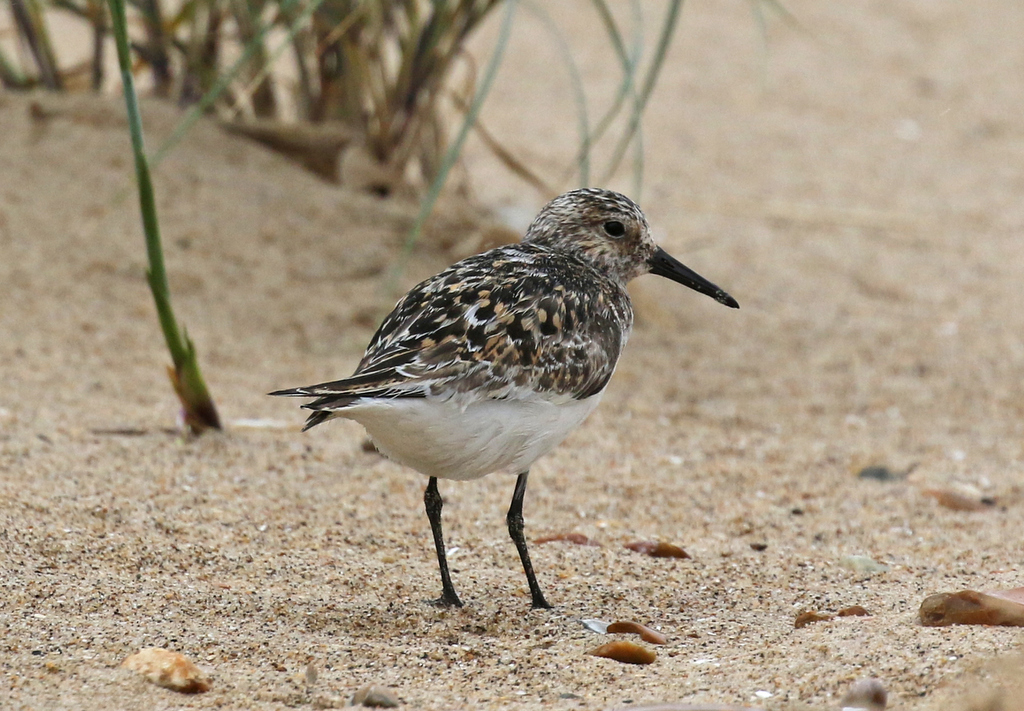
One of the Little Terns flew over calling. It started to drizzle more heavily now, so we decided to walk back to get our waterproofs from the minibus. From the dunes, we could see the pair of Little Terns mobbing an Oystercatcher back on the beach. Hopefully they had not been impacted by the high tides.
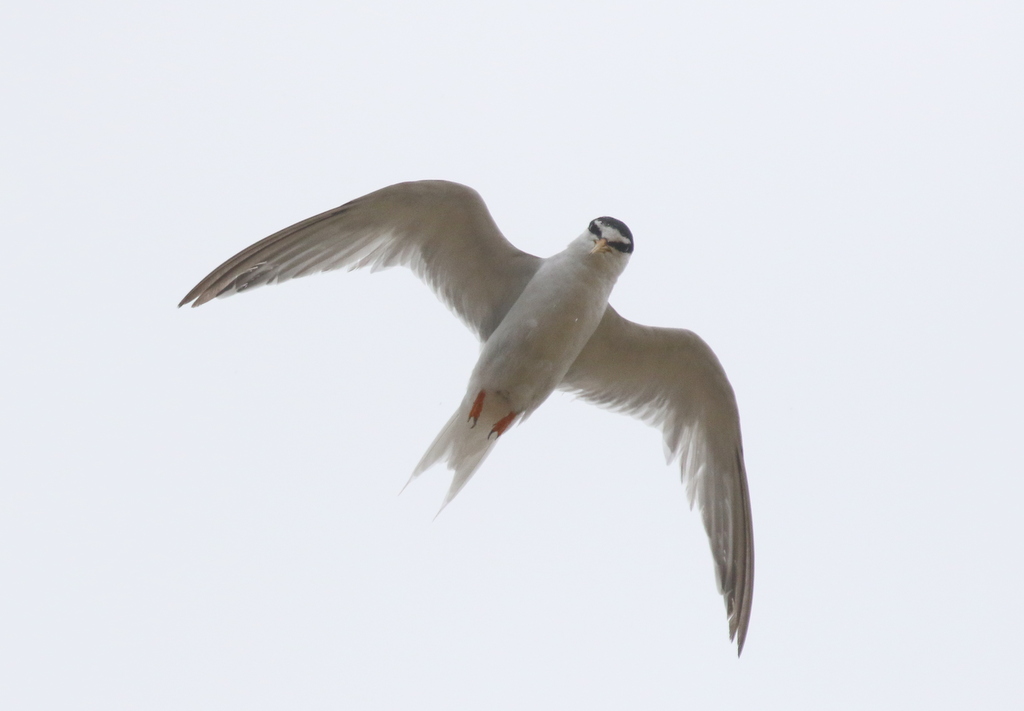
It had stopped drizzling again when we got back on the coastal path. Lots of Linnets and Meadow Pipits were in feeding in the dunes. Back at the minibus, we layered up just in case. A Cuckoo flew across the grazing marshes on the other side of the track and when we looked across we could see a second Cuckoo perched on the top of some brambles. We had a look at it in the scope. It will not be long now before the adults leave and head off back south, their breeding season over and the surrogate parents left to raise the young.
We wanted to have a quick look in the old paddocks, so we walked back round and up onto the coastal path. But when we got there it started drizzling more heavily again, so we decided to change plans and head round to Titchwell instead, where we could use the hides. When we got to Titchwell, we had a quick look at the latest rainfall radar and realised the rain band looked to be moving over quickly, so we stopped for coffee at the Visitor Centre. Afterwards the rain had eased off again, so we headed out onto the reserve.
When we got out to the reedbed, a Reed Bunting was singing from the top of a small sallow. A few Sedge Warblers and Reed Warblers were flitting round the small pools below the path. A small flock of waders flying in over the saltmarsh turned out to be a Whimbrel with ten Redshank. The latter dropped down on the saltmarsh, but we watched the Whimbrel disappear out over the Freshmarsh.
There were lots of ducks on the reedbed pool, mainly Mallard, Gadwall and Common Pochard with a single Tufted Duck. The drakes are now all in their drab eclipse plumage. A single Red-crested Pochard sailed out from the reeds. It looked rather like a female, apart from its bright coral-red bill – it was a drake in eclipse too. A couple of Mediterranean Gulls flew off over the reeds, flashing their white wing tips.
We continued on to Island Hide. There were several Black-tailed Godwits feeding on the mud in front of the hide. One of them was bearing a collection of colour rings including one with the letter ‘E’ and a flag with the number ’27’. This bird is a Continental Black-tailed Godwit, from the very small UK breeding population on the Nene Washes.
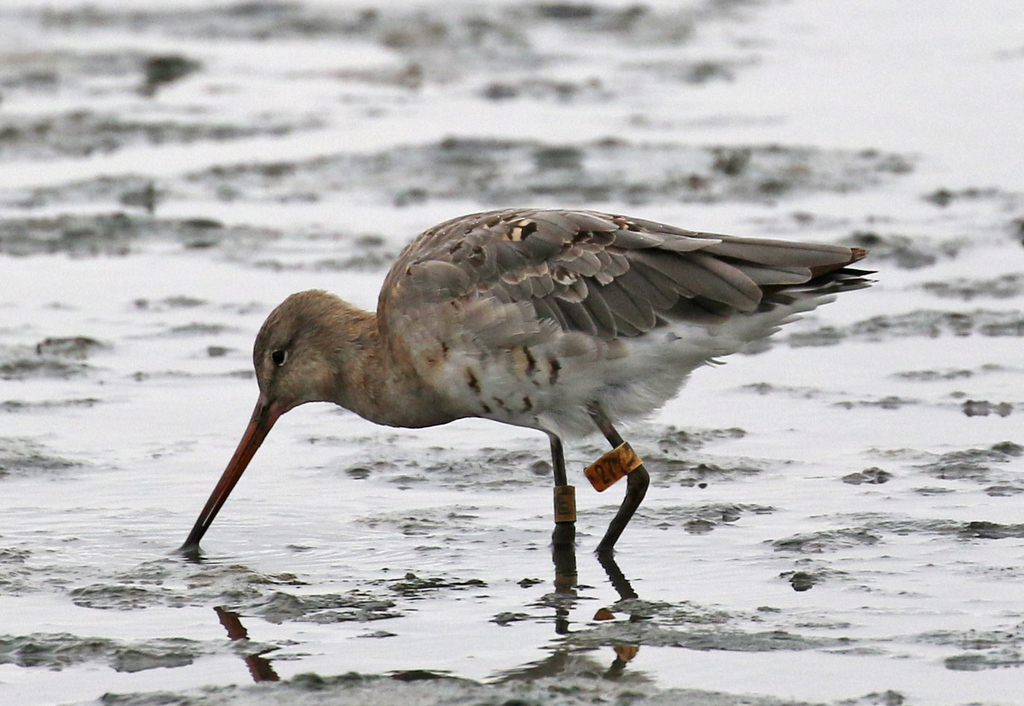
In order to try to help the struggling UK breeding population of Continental Black-tailed Godwits, a number of eggs are now being hatched and raised in captivity each year, before being released once they are fully grown. ‘E27’ is one of those, raised in 2018. After spending the winter in Spain, it has since toured East Anglia.
Most of the birds here are Icelandic Black-tailed Godwits, which are faring much better. There were lots of them out on the Freshmarsh today, and there seemed to be birds moving too. A large flock had flown off as we walked up towards Island Hide, disappearing off west. We saw more flying off or over during the morning, and others dropping in.
A small group of Knot was out with the Black-tailed Godwits when we first arrived and we had a look at them through scope. But they had disappeared when we looked back, possibly out to the beach or perhaps they were on the move today too. We counted 44 Dunlin on the Freshmarsh, but there had apparently been 83 earlier – again waders were obviously dropping in and moving on.

There were about a dozen Ruff here today, all of them different colours. They are all males which have finished breeding, and already moulted their ornate ruffs. Some were looking very scruffy, with very scrawny necks. An adult Avocet and a well-grown juvenile were feeding in front of the hide, but there were lots more resting on the islands out in the middle. The Avocets are gathering here to moult now, with birds travelling here from elsewhere, and over 400 were counted here today. A single Spotted Redshank was visible over by the fenced-off Avocet Island but was rather distant from here.
The juvenile Bearded Tits like to feed along the edge of the reeds in front of Island Hide and we looked across to see three working their way round, hopping out onto the edge of the mud. We had a great look at them, tawny brown with black backs and black masks.
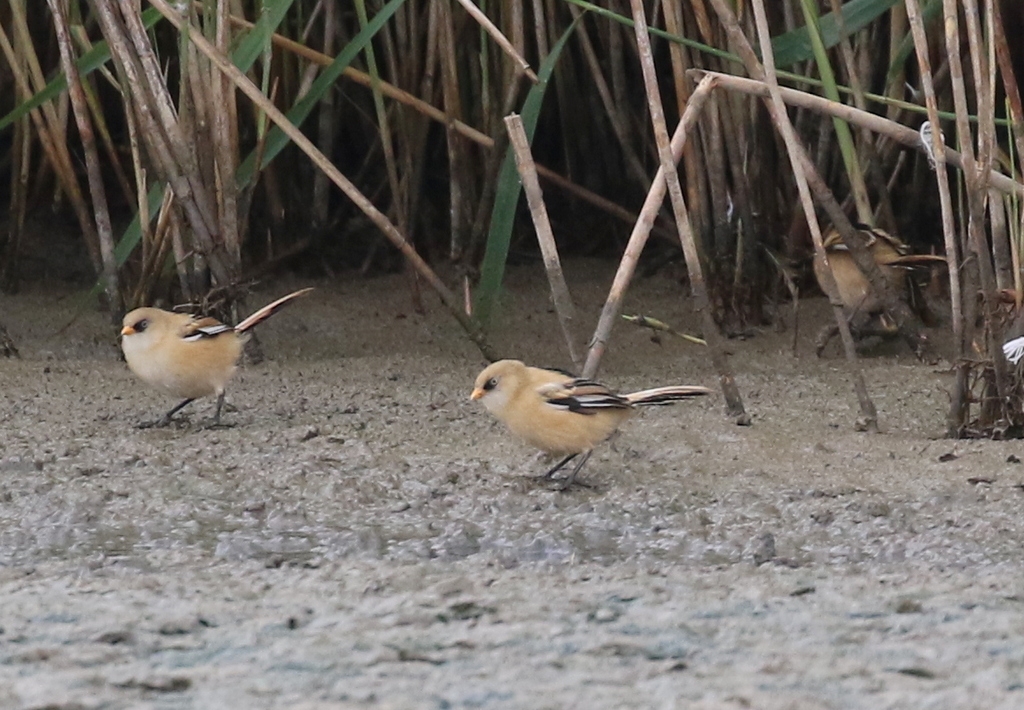
Spoonbills were reported on the Freshmarsh this morning, but they were apparently over in the back corner and not in view from here. One of the volunteers radioed through to a colleague over by Parrinder to check they were still present, and the reply came through that they were just taking off. We looked over to see six of them flying low towards us, they passed right in front of the hide, before disappearing off west over the bank, presumably heading to to feed.

There are still lots of gulls out here, and plenty of Mediterranean Gulls loafing around on the islands in with all the Black-headed Gulls. A couple of Common Terns were out on one of the islands too.
Four Barnacle Geese flew in over the back from the direction of Brancaster and landed on the island in front of Parrinder Hide. When we walked round, we had a better look from there. They are presumably feral birds from the now established UK breeding population, which tend to wander.
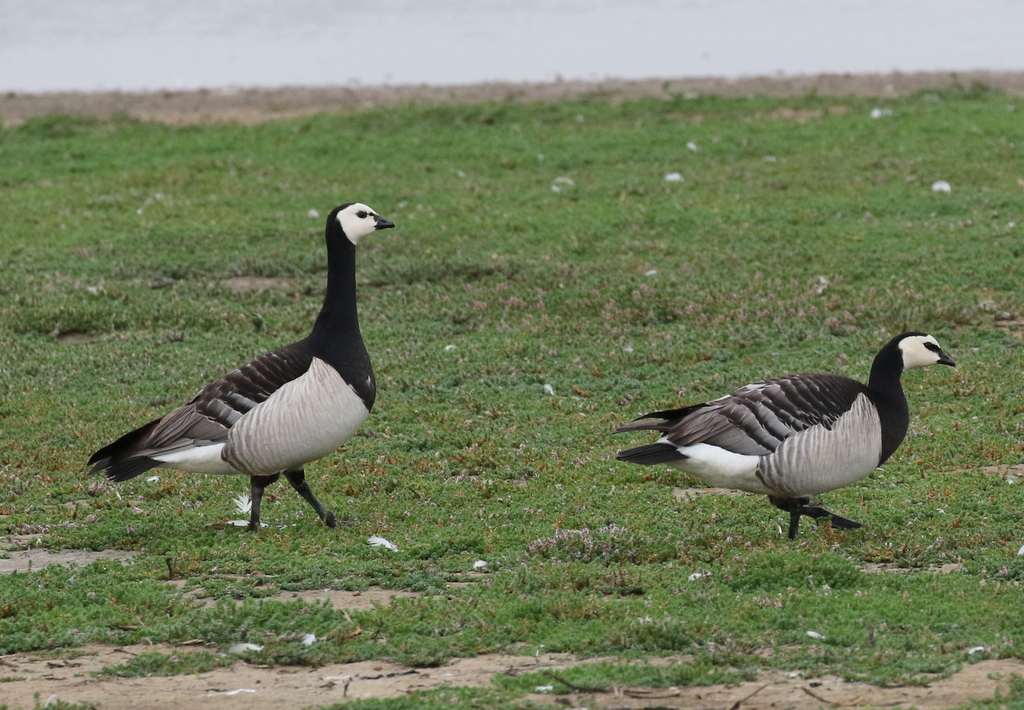
We had a closer look at the gulls from Parrinder Hide. There were lots of juvenile Mediterranean Gulls, much greyer and scalier than the rather dark brown juvenile Black-headed Gulls. Several of the juvenile Mediterrnaean Gulls were begging from the adults.
There was a much better view of the Spotted Redshank by the Avocet Island fence from here too. It was still mostly in sooty black breeding plumage but starting to moult now with patches of paler grey emerging. At least four more Spotted Redshanks were right over the far side, on the edge of the reeds. A couple of those were already noticeably whiter below than the others.

There were more ducks loafing on the islands over this side of the Freshmarsh, the drake all in drab eclipse plumage. Teal and Shoveler were both additions to the day’s list. Hundreds of Swifts had gathered over the reeds, and we could see a few House Martins and Sand Martins in with them. They were hawking low, trying to find insects in the cool and rain. There had been a steady passage of Swifts moving west along the coast today.
It was lunchtime now, so we set off to walk back. We had a quick look over the wall at Volunteer Marsh, but there wasn’t much on there – a single Curlew, an Oystercatcher, and a Lapwing. We hadn’t got back to the trees before it started to spit with rain again. As we didn’t fancy sitting out in the rain, we decided to divert round via Meadow Trail before lunch. A Song Thrush was singing on Fen Trail, perched right on the top of a dead tree. We stopped to watch a pair of Blackcaps feeding their young in the bushes behind Fen Hide.
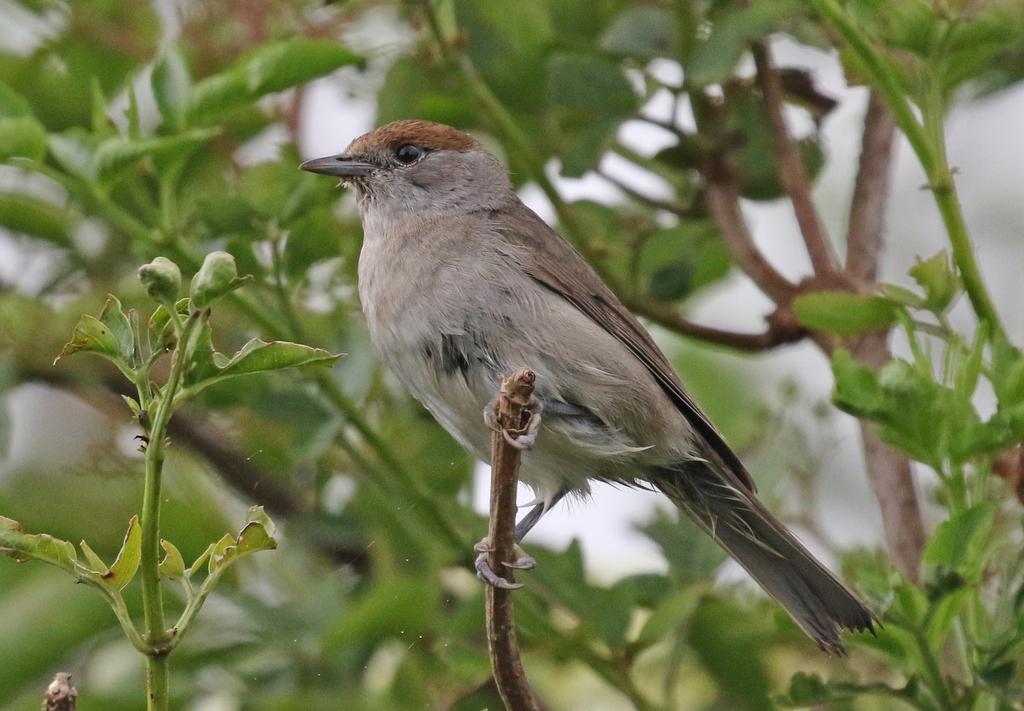
The drizzle had stopped by the time we got round to Patsy’s and there were lots more warblers in the bushes around the screen, coming out to feed after the rain. We saw several Common Whitethroats and a couple of Chiffchaffs, as well the usual Reed Warblers. A couple of Bearded Tits zipped back and forth across the reeds.
There were lots of ducks on Patsy’s, mainly Mallard and Gadwall, the drakes all in eclipse. A female Common Pochard with several ducklings was diving out in the middle. Two more Red-crested Pochard were again drakes in eclipse, given away by their bright red bills.
When we finally got back to the Visitor Centre, it was time for a rather late lunch. We were very kindly allowed to eat inside as it was not busy today and the clouds still looked rather threatening. Afterwards, we made our way back east along the coast and stopped again at Burnham Overy Staithe.
As we walked out along the seawall, we saw a distant Spoonbill fly across over the harbour towards the dunes. A male Kestrel landed in the top of the hawthorn bushes on the near edge of the grazing marshes and a couple of Greylag heads popped up from time to time out of the long grass beyond. A Little Grebe was diving in the channel on the edge of the reeds and we stopped to watch a family of Sedge Warblers down in the wet grass below the bank.
There were a few waders out in the harbour. A flock of Redshanks around the small pools on the sandbanks and more with a flock of roosting Black-tailed Godwits on the mud on the corner. There were several Oystercatchers too, but it was very disturbed today with several boats in the channel and people walking out over the middle of the saltmarsh and round the edge of the harbour.
We stopped on the corner by the reedbed pool. There were lots of Coot and a few ducks on the water and we could hear Bearded Tits calling from the reeds. Then a Black Tern appeared over the pool. It circled round over the reeds, giving us a good look at it. It was a very smart adult, still in sooty black breeding plumage. Then as quickly as it had appeared it flew up and over the bank and disappeared out over the harbour. There had apparently been a Black Tern here a couple of days ago, so it was possibly lingering here.
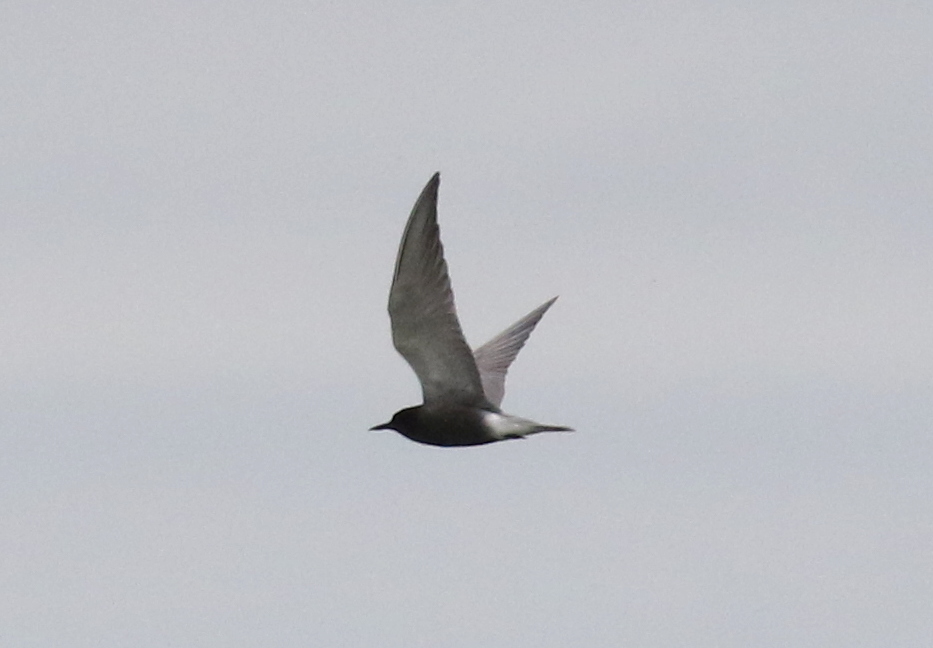
There were some cattle grazing on the marshes further up along the bank, so we walked over. There had been some Cattle Egrets with them earlier this week, but there didn’t seem to be anything there at first today. We stood and looked out over the grazing marshes and we were just about to head back, when the Cattle Egrets suddenly appeared. They were not feeding around the cows, but on a small pool hidden in the long grass in between them. We couldn’t see the Cattle Egrets behind the tall vegetation until they happened to walk out into the open, just in time.
We had a good view of the Cattle Egrets through the scope. They were looking particularly smart, in breeding plumage with a pale orange wash on the top of the head, the back and breast. Then they flew back to join the cows further back and we lost them from view again in the long grass.
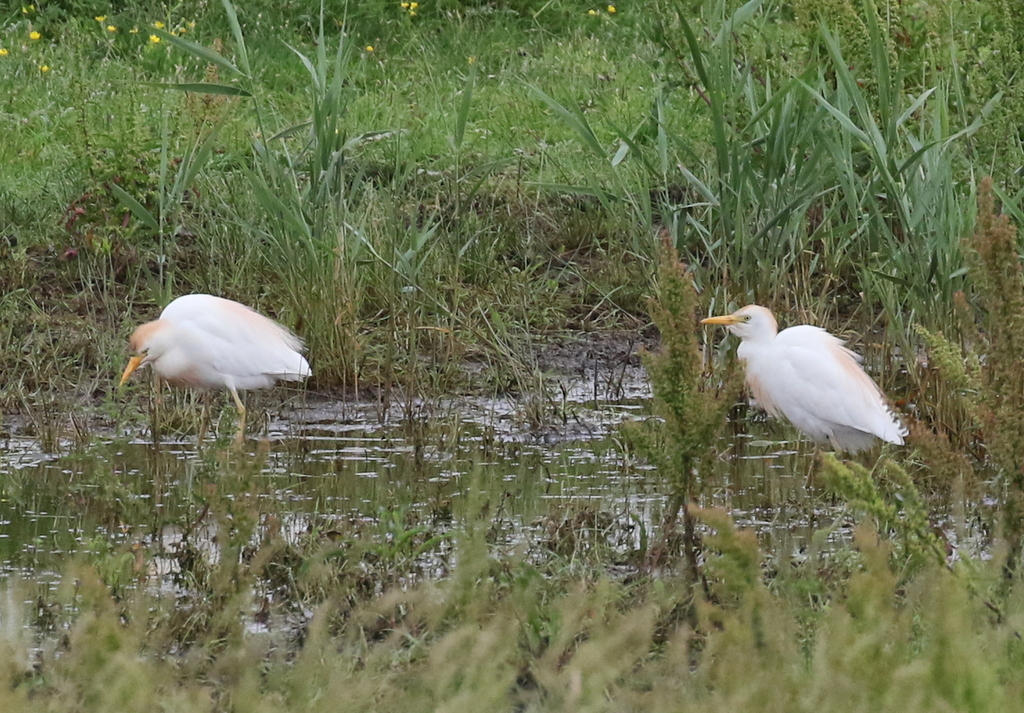
A Spoonbill flew in over the harbour and out across the grazing marshes, heading for the breeding colony. As we walked back, we were almost at the car park and had stopped to look out over the marshes, when another Spoonbill dropped in behind us into the harbour channel. It would have been a great view, but there were more people out with dogs paddling in the harbour, and they flushed it as we turned round to look at it.
We were heading out again this evening, looking for Nightjars, so it was time to head back now, so we could all have a break and get something to eat.
Nightjar Evening
When we met again in the early evening, the weather was much improved, and the sun was even shining. We headed over first to look for Little Owls at a nearby complex of barns. We were in luck tonight. As we pulled up and started to scan the roofs, we spotted two fluffy juvenile Little Owls perched on the top enjoying the evening sun.
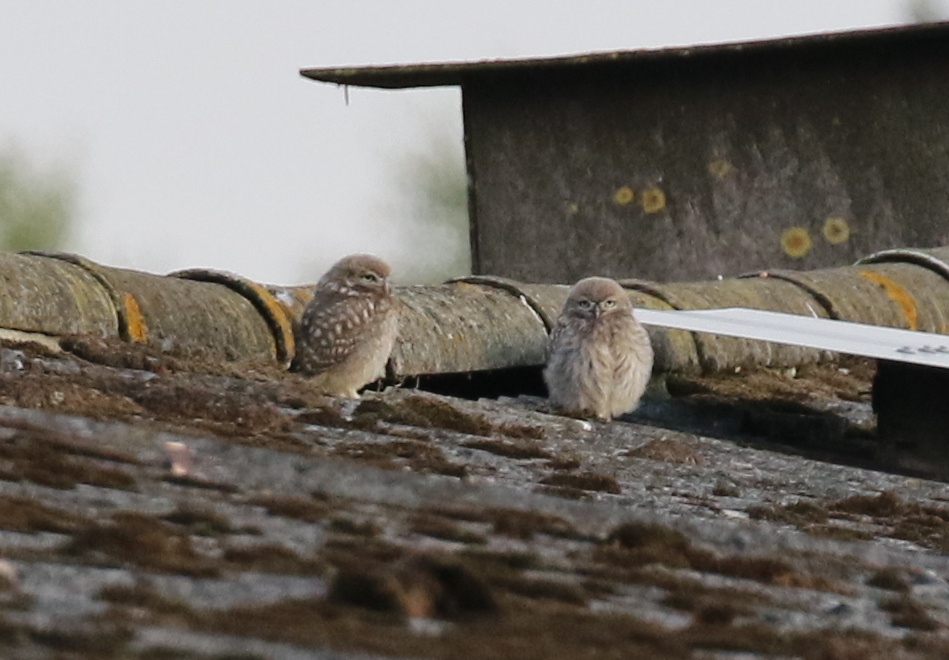
One of the adult Little Owls appeared on the roof opposite, and one of the juveniles flew over to see if it was going to be fed. We stopped and watched them for a while and there was lots of flying backwards and forwards between the roofs. A second adult appeared on another roof, which we assumed was the other parent, but the first adult flew over straight at it as if it was trying to chase it off. The second Little Owl flew a short distance, but it landed on the same place we had first seen the two juveniles and was ignored thereafter, so it was hard to be sure what its relationship was to the others.
Eventually we had to tear ourselves away – we could have stayed watching the Little Owls all evening but we wanted to head down to the coast to look for Barn Owls. We drove round some meadows where they like to hunt, but there was no sign initially of any out tonight. We stopped, and walked up onto a bank from where we could scan the grazing marshes.
When we looked back, we found a Barn Owl out hunting the field behind us, where we had just been looking. It flew round and landed on some bales, but by the time we got the scopes out, it was off again. It landed a second time, on a fence below the bank by the reeds, and this time we had a good view, perched looking at us. It dropped down to the ground and flew back up to the fence. Then it was away over the reeds.
We turned to see a second Barn Owl had flown along the bank right behind us and was disappeared off out over the marshes. It was a striking almost all-white male, a regular bird here. It disappeared away out of view before we could get a good look at it, but thankfully quickly caught something and came back with a vole in its talons.
It flew straight towards us initially, then veered off and disappeared into the trees, presumably heading back to its nest to feed its young. Only a short while later, it was out hunting again. It flew round over the meadows, where we had seen the first Barn Owl, then came past us across reeds and disappeared out over marshes.

It was time now to head up to the heath for the evening’s main event. It was quiet as we walked out to the middle, but not long before we heard our first Nightjar calling. We looked over to see it flying round the treetops in the distance. It started churring so we walked over to look for it.
The Woodcock were still roding too. We heard a squeaky call, and looked up to see one flying over, with flicking wingbeats, it distinctive display flight. It or another came right over us a couple of times this evening.
The Nightjar was churring in a dense oak, and impossible to see in the evening gloom. We stood nearby and listened and after a while it dropped out and came towards us over the heath. Then a female appeared, and came in to investigate, hovering right in front of us. We had a great view as it flew round just above our heads.
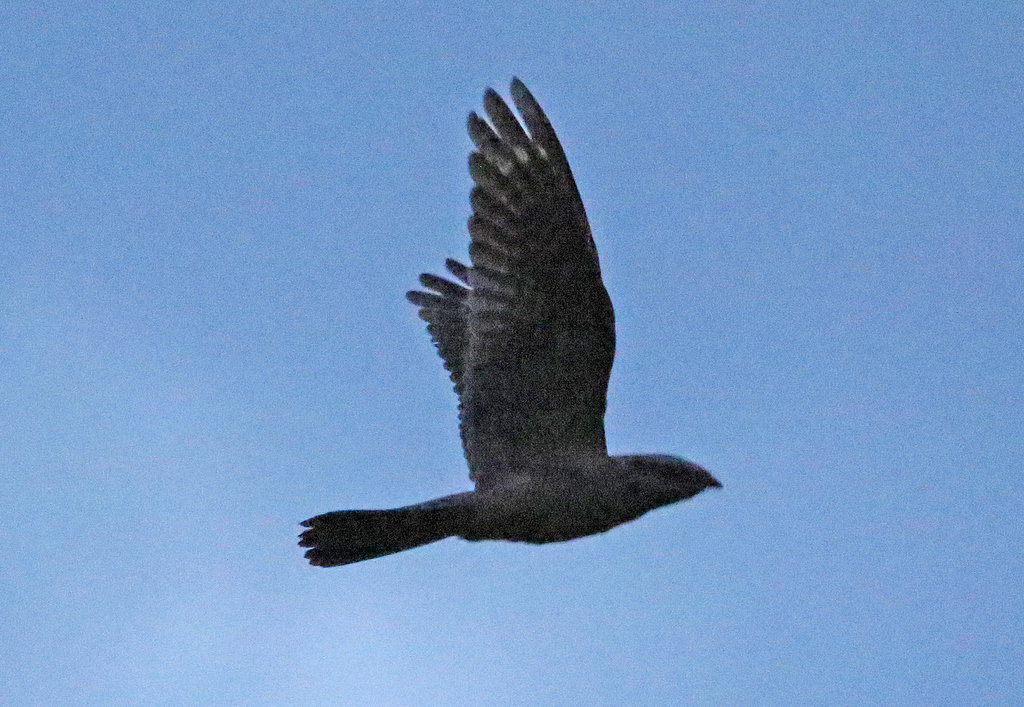
When the female Nightjar flew back towards the trees, a second male came in, and the two of them flew round together calling, the flashing the white in his wings and tail. The first male was still churring out in the middle of the heath, while an intruder was on its territory. These two birds often seem to have dispute, and after a while the first Nightjar flew back off towards its territory.
We stood for a while and listened to the Nightjars churring. Occasionally one would fly in and circle round above us again. A Tawny Owl hooted from deep in the woods behind. The light was fading now, so we set off to walk back. We heard another couple of churring male Nightjars on our way back to the minibus. Then it was time for bed – we had another busy day tomorrow.
















